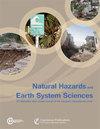事件尺度短时山洪水文气象预报评价方法框架
IF 4.7
2区 地球科学
Q1 GEOSCIENCES, MULTIDISCIPLINARY
引用次数: 1
摘要
摘要本文提出了一种基于事件评价的短期水文气象集合预报方法框架,并以一次具有高时空变异性的强山洪事件为例进行了研究。拟议的评价采用负责在区域范围内组织疏散和救援行动的最终用户的观点。因此,应及时预测局部超过放电阈值,准确定位。提出了一种循序渐进的方法,包括首先对降雨预报进行评估。这第一步有助于我们确定适当的空间和时间尺度来评估洪水预报。然后,在大量未测量的子集水区,使用模拟流量和零未来降雨量预测作为参考,分析洪水上升边缘(流量阈值)的预测。在第二步的基础上,选择了几个测量的子集水区,在这些集水区,最终实现了对预测水文曲线的详细评估。2018年10月的山洪暴发影响了奥德河流域(法国东南部)的部分地区,并对该方法进行了测试和说明。评价和比较了法国气象组织最近提出的三种降雨近预报研究产品。结果表明,在考虑较大集合百分位数(例如第75百分位数)的情况下,这些产品正确地检索了观测到较大降水积累的区域,但有高估其空间范围的倾向。水文评估表明,与天真的未来零降雨情景相比,排放阈值超标更能定位和预测,但代价是误报率显著增加。同时指出了三种集合预报产品在性能上的差异。最后,尽管由于现有数据的统计代表性有限,基于少量记录洪水事件的综合水文气象预报的评估仍然具有挑战性,但本文提出的评估框架应有助于得出关于新开发的降雨预报系统对山洪预报的有用性,以及它们的局限性和可能的改进的初步结论。本文章由计算机程序翻译,如有差异,请以英文原文为准。
A methodological framework for the evaluation of short-range flash-flood hydrometeorological forecasts at the event scale
Abstract. This paper presents a methodological framework designed for the event-based evaluation of short-range hydrometeorological ensemble forecasts, in the specific context of an intense flash-flood event characterized by high spatiotemporal variability. The proposed evaluation adopts the point of view of end users in charge of the organization of evacuations and rescue operations at a regional scale. Therefore, the local exceedance of discharge thresholds should be anticipated in time and accurately localized. A step-by-step approach is proposed, including first an evaluation of the rainfall forecasts. This first step helps us to define appropriate spatial and temporal scales for the evaluation of flood forecasts. The anticipation of the flood rising limb (discharge thresholds) is then analyzed at a large number of ungauged sub-catchments using simulated flows and zero-future rainfall forecasts as references. Based on this second step, several gauged sub-catchments are selected, at which a detailed evaluation of the forecast hydrographs is finally achieved. This methodology is tested and illustrated for the October 2018 flash flood which affected part of the Aude River basin (southeastern France). Three ensemble rainfall nowcasting research products recently proposed by Météo-France are evaluated and compared. The results show that, provided that the larger ensemble percentiles are considered (75th percentile for instance), these products correctly retrieve the area where the larger rainfall accumulations were observed but have a tendency to overestimate its spatial extent. The hydrological evaluation indicates that the discharge threshold exceedances are better localized and anticipated if compared to a naive zero-future rainfall scenario but at the price of a significant increase in false alarms. Some differences in the performances between the three ensemble rainfall forecast products are also identified. Finally, even if the evaluation of ensemble hydrometeorological forecasts based on a low number of documented flood events remains challenging due to the limited statistical representation of the available data, the evaluation framework proposed herein should contribute to draw first conclusions about the usefulness of newly developed rainfall forecast ensembles for flash-flood forecasting purpose and about their limits and possible improvements.
求助全文
通过发布文献求助,成功后即可免费获取论文全文。
去求助
来源期刊
CiteScore
7.60
自引率
6.50%
发文量
192
审稿时长
3.8 months
期刊介绍:
Natural Hazards and Earth System Sciences (NHESS) is an interdisciplinary and international journal dedicated to the public discussion and open-access publication of high-quality studies and original research on natural hazards and their consequences. Embracing a holistic Earth system science approach, NHESS serves a wide and diverse community of research scientists, practitioners, and decision makers concerned with detection of natural hazards, monitoring and modelling, vulnerability and risk assessment, and the design and implementation of mitigation and adaptation strategies, including economical, societal, and educational aspects.

 求助内容:
求助内容: 应助结果提醒方式:
应助结果提醒方式:


